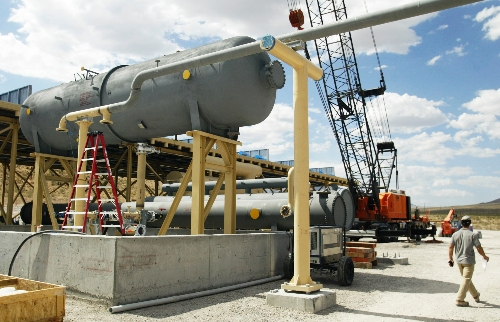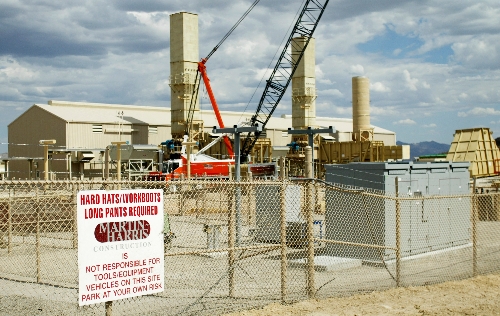NV Energy plant repurposes heat from natural-gas compression to yield energy


Next time you hop onto Interstate 15 and drive toward California, look off to the west at the Goodsprings exit, about 35 miles south of Las Vegas.
There, in the distance, you’ll see a perfectly pedestrian building — your garden-variety steel-clad, neutral-toned industrial plant.
But what’s happening at the site is beyond the ordinary.
It’s the location of electric utility NV Energy’s Goodsprings Waste Heat Recovery Plant, the first power plant of its kind in Nevada. It’s also NV Energy’s first nonsolar green-energy project, and it’s the first renewable generating station that the utility actually owns.
What’s more, the Goodsprings plant offers key attributes that solar power and wind energy lack: It can run around the clock, every day.
“(Goodsprings) will be dependable 24-7, and it’s one of the lowest-cost renewables in our portfolio,” said Andy McNeil, NV Energy’s executive of New Generation Project Management. “Those are the things that are important to me as an NV Energy customer.”
The Goodsprings plant will produce 6 megawatts of electricity, enough to power 3,600 Southern Nevada homes. The station, which broke ground in March and is scheduled for completion in October, is costing just north of $20 million to build. Tom Fair, the utility’s vice president of renewable energy, wouldn’t disclose the plant’s power cost per kilowatt hour, but he said the price will likely be lower than the cost of geothermal energy, which is the cheapest form of clean power in the utility’s portfolio.
Fair didn’t disclose the cost of geothermal power that NV Energy buys, but a 2009 report from investment bank Credit Suisse found it cost 5.5 cents per kilowatt hour to generate electricity from unsubsidized geothermal projects built with lower-interest construction loans (the study pegged the cost to produce power from coal plants at 5.5 cents per kilowatt hour as well).
Waste-heat generation is less pricey than other forms of green energy because it uses existing technologies, McNeil said.
To understand how waste-heat recovery works, start with the heat source.
The Kern River Gas Transmission Co., based in Salt Lake City, runs a 1,680-mile underground pipeline it uses to ship compressed, liquefied natural gas from Wyoming, where it’s extracted, to Bakersfield, Calif. The line, which supplies 80 percent of the natural gas used in the Las Vegas Valley, runs just west of the city, and has Nevada compressor stations at Dry Lake and Goodsprings. Those stations generate heat during compression, and the plants release that heat through exhaust stacks.
At Goodsprings, three exhaust pipes punctuate the desert; NV Energy and Ormat are installing valves inside each stack to divert the exhaust heat to a generating station next to the gas compressors. That heat turns a separate generator that then produces electricity. The plant will use dry-cooling technology to save on water.
NV Energy is looking at other waste-heat projects, including plants that would lasso heat from landfills. Waste-heat recovery plants will always be small, around the size of Goodsprings, Fair said, but the projects are important because they build and diversify the company’s renewable portfolio.
Ormat Technologies, a Reno-based geothermal builder and manufacturer, is providing the technologies to capture waste heat at Goodsprings, and Kern River is charging NV Energy a “small payment” to lease the heat-exhaust stacks, Fair said. NV Energy owns 100 percent of the plant. The facility will connect to NV Energy’s Jean substation via a 69,000-kilovolt transmission line that parallels Interstate 15.
“The team created between Kern River, Ormat and NV Energy is a good team, and we are learning,” McNeil said. “We will take the efficiencies involved in this project to the next one.”
The plant will create 30 building jobs at peak construction, though it won’t have any full-time staff once it’s complete.
NV Energy representatives also said Friday that they fell short in 2009 on meeting the state’s mandated renewable-portfolio standard, which requires the utility to get a share of its electricity from cleaner generation sources.
The standard’s requirements increase gradually, maxing out at 25 percent in 2025. In addition to renewable generation, improved energy conservation among ratepayers and energy credits count toward the portfolio.
NV Energy met the mandate for the first time in 2008, hitting the 9 percent the law required.
The standard jumped to 12 percent in 2009; NV Energy made it to 10.5 percent. The utility missed its standard due to project timing, Fair said.
“It’s the kind of thing where projects come in spurts. It’s not a smooth climb uphill,” Fair said. “There are innumerable ways a project can be delayed or even killed. Sometimes you get lucky and things get done ahead of schedule.”
Fair said the utility will more than make up lost ground in 2010, thanks to new additions such as the Goodsprings Waste Heat Recovery Plant. The mandate stays at 12 percent in 2010, and NV Energy expects to hit 14 percent at year’s end, Fair said.
NV Energy’s 1,200-megawatt green-power portfolio contains 44 projects that are on line, under construction or planned. Most of its clean-fuel projects use solar power in Southern Nevada and geothermal generation in Northern Nevada.
Contact reporter Jennifer Robison
at jrobison@reviewjournal.com or 702-380-4512.












